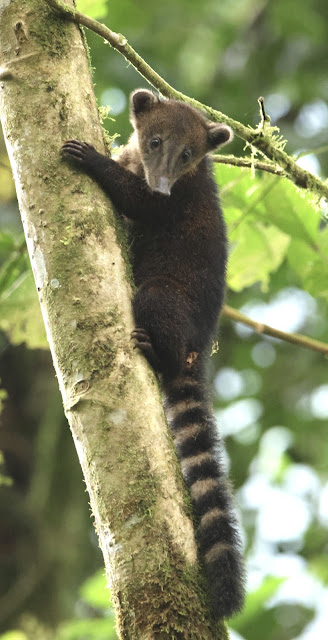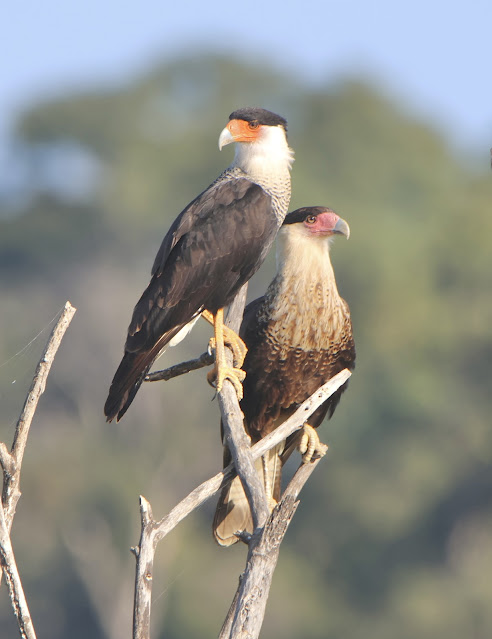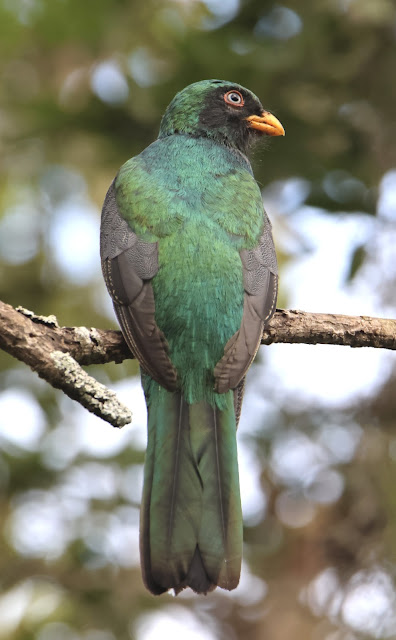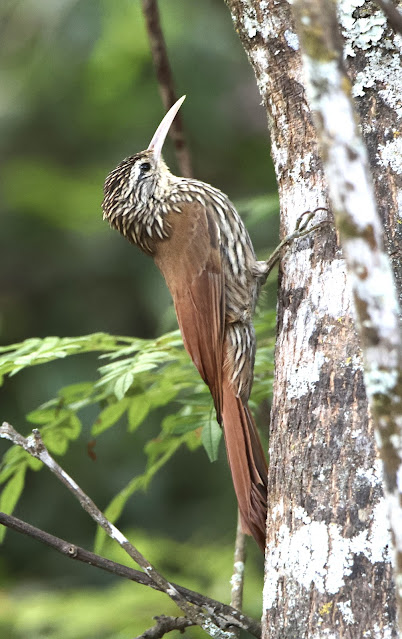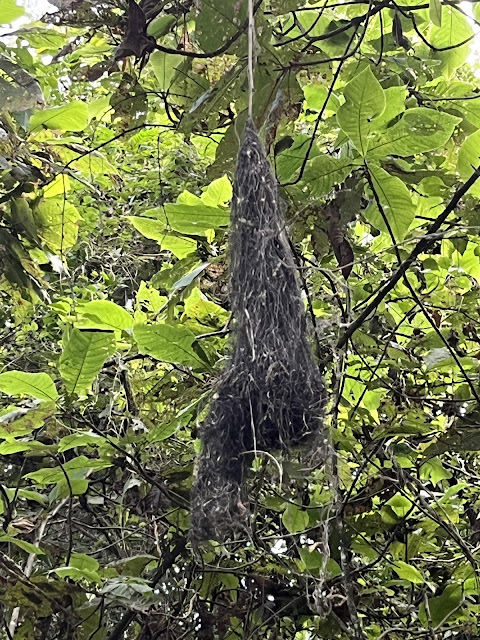For some time I’ve have been eyeing a certain birding lodge about 4 hours to the east called the Umbrellabird Lodge, which lies within the Buena Ventura Reserve. We finally had good reason for a diversion there, but it was not how we would have planned such. Our beautiful cat Buster passed away, a real heartbreaker, so we decided to get away.
Wednesday, July 16, we left home mid morning, driving over to Catamayo where the local airport is, and heading west from there. Using Google Maps we took the shortest route. Just a few miles beyond Catamayo we veered off to the right and headed farther out into the country, but after a few miles the pavement ran out. At least it was a decent gravel road, and we unexpectedly ended up running a ridge for a half hour or so before meandering down to a river valley where we finally reached the pavement again.
 |
| A TYPICAL RIVER VALLEY - SEEN FROM THE RIDGE WE DROVE ON |
Not long after we came to the towns of Portabelo and Pinas, both mining towns, and we were glad to get past them. After leaving Pinas we headed up over a pass, and for the next half hour or so descended through the undisturbed forest of the huge Buena Ventura Reserve. Everything was lush and green. We finally found the turn off to the UmbrellaBird Lodge. That road was NOT paved, full of pot holes and muddy puddles here and there, most of it going uphill. After about 4 miles of slow driving we reached the lodge.
 |
| THE UMBRELLABIRD LODGE |
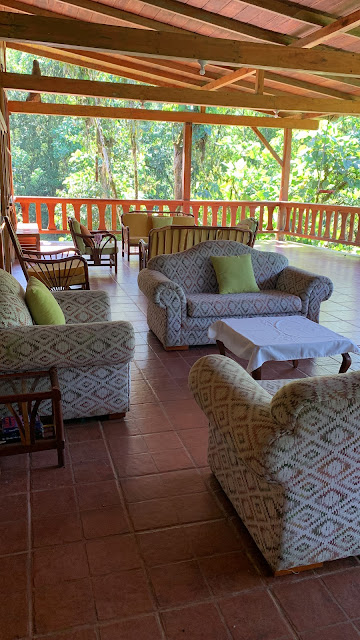 |
| THE LARGE PORCH OF THE LODGE |
 |
| THE DINING AREA |
Now when you see those huge morpho butterflies flitting about and heliconias everywhere and feel the humidity, you know you are in the jungle. There were only 3 cabins, all with 2 rooms. The lodge itself was nice, with screening to divide the dining area from the huge porch. This was certainly needed to keep out the family of Coatis who came looking for food.
The hummingbird feeders were alive with the activity of 5 species of hummers.
Green Honeycreepers and Bananaquits also pigged out on the sugar water:
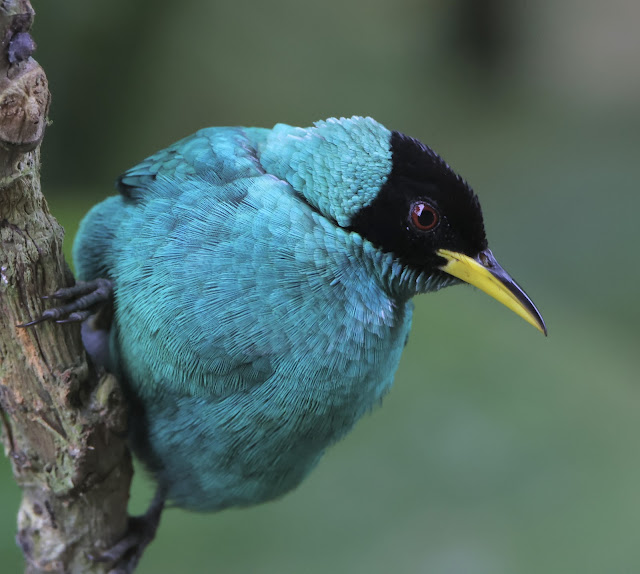 |
| GREEN HONEYCREEPER |
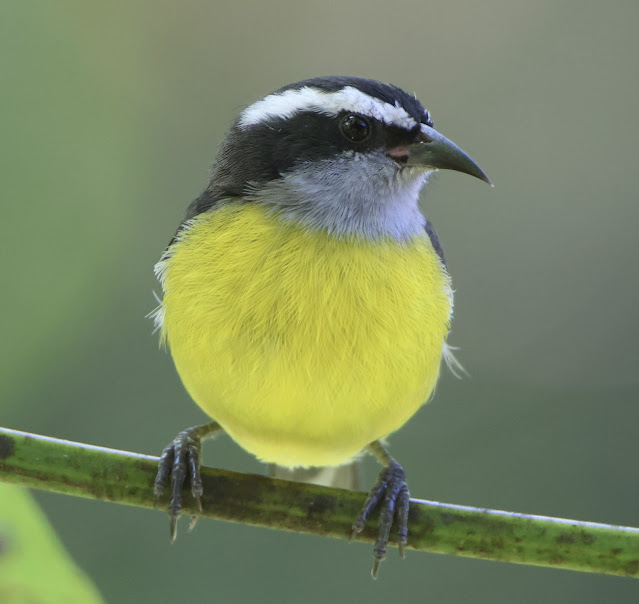 |
| BANANAQUIT |
I noticed two other birders and their guide there, and after striking up a conversation with one, I learned that I knew their guide - Juan Carlos Figueroa from Guayaquil. I had hired him 4.5 years ago when in his area while awaiting the results of a Covid test. So we got reacquainted. He explained that in the present dry season birds are spread out because food is more widely available, and some are not at their lek sight. This would explain why the Umbrellabirds were not seen by them that morning.
 |
| JUAN CARLOS AND ME |
After dinner Juan went outside and called in the local Black-and-White Owl, came back in to herd us outside to see him. Just down the steps he shined the light straight up into one of the cecropia trees, and we all had great looks at him. One of these days I hope to be able to take pics of one on a day perch.
The next morning I was off early with the lodge guide to the Umbrellabird lek. A lek is a small area where male birds gather and call for the females. As fate would have it, none were there. So the guide and I spent a couple hours walking farther up the mountain. It was eerily quiet with hardly any birds heard. But after about 30 minutes they started showing up: Rufous and Broad-billed Motmot, White-whiskered Puffbird, Scaly-throated Foliage-gleaner, Northern Schiffornis, Western Woodhaunter, White-throated Spadebill, Collared and Gartered Trogons, Song Wrens, and others. The best find was this White-tipped Sicklebill, certainly a unique hummingbird:
 |
| WHITE-TIPPED SICKLEBILL |
After breakfast my wife Rosie came with us going downhill, the opposite direction, although she turned around when it got too hot. Some additions were a Chestnut-headed Oropendola, White-shouldered Tanager, Slaty Spinetail, Black-faced Dacnis, Brownish Twistwing, Black-crowned, Russet, Chestnut-backed and Esmeraldes Antbirds, Bronze-winged Parrots, Red-masked Parakeets, Roadside and Short-tailed Hawks. A very welcome surprise was this Ornate Hawk Eagle who was after a Crested Guan.
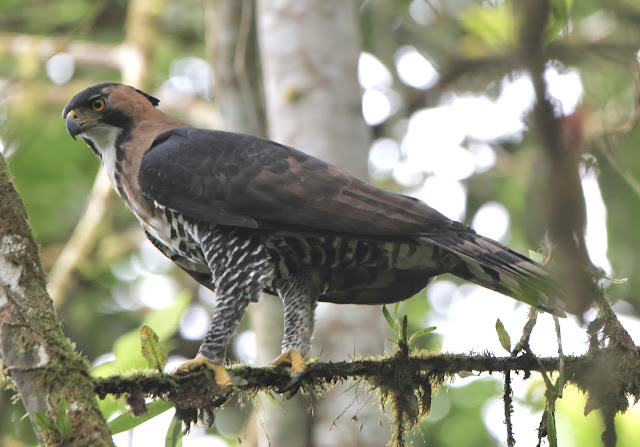 |
| ORANTE HAWK EAGLE |
In the afternoon we returned to the Umbrellabird lek, but still no sign of one. Early the next morning we’d try again. The trail descends a ways downhill. They made interesting use of used tires by placing them where steps are needed, and filling them with concrete. Long before we reached the bottom we heard the unmistakable call of one. Just like a fog horn. The guide, Holger, gave me the thumbs up, indicating a sure thing. When we got to the bottom we spied one only 30 feet above us. The lighting was not good for photography, but I snapped a few pics anyway.
As there was a 2nd bird calling not far off, we headed in that direction. However, a Black-howler Monkey distracted us, hissing down upon us. I took a few pics, but the light was still not great, and they turned out fuzzy. The lighting was a little better for photographing the 2nd bird. Holger suggested I get closer for better photos. So here is my best shot:
 |
| LONG-WATTLED UMBRELLABIRD |
I suspect the birds which come to the lek are used to the presence of people as they did not spook with me being so close. It was a great experience. On the way back up another lifer was awaiting me. We noticed a Yellow-throated Toucan being rather uneasy about something, which turned out to be this Bicolored Hawk.
 |
| BICOLORED HAWK |
 |
| YELLOW-THROATED TOUCAN |
 |
| CHOCO TOUCAN |
From there we drove back down to the river, near the turn off for the lodge looking for my last hoped for lifer - a Royal Flycatcher. We parked just after a bridge and began to walk. Bird activity was very good, but we did not stay focused on any particular bird as we were after Royalty. The road was flat and paralleled the river and after about 1/3 mile Holger heard one. He played the song and after a bit, this Royal Flycatcher came in, and here is my best picture:
 |
| ROYAL FLYCATCHER |
While walking back to the car we saw a white egret type of bird down along the river’s edge. I snapped a few pics. It was an immature bird, either a Snowy Egret or a Little Blue Heron. They are difficult to distinguish when young, but my pics verified it as a Snowy Egret. Funny that of all the birds seen during our time there, this would be the rarest for the area. eBird had it flagged, needing documentation, so my picture with a short description was supplied.
 |
| IMMATURE SNOWY EGRET |
Here are a few other bird pics from Buena Ventura and the Lodge area: |
| WHITE-SHOULDERED TANAGER |
 |
| TROPICAL PARULA |
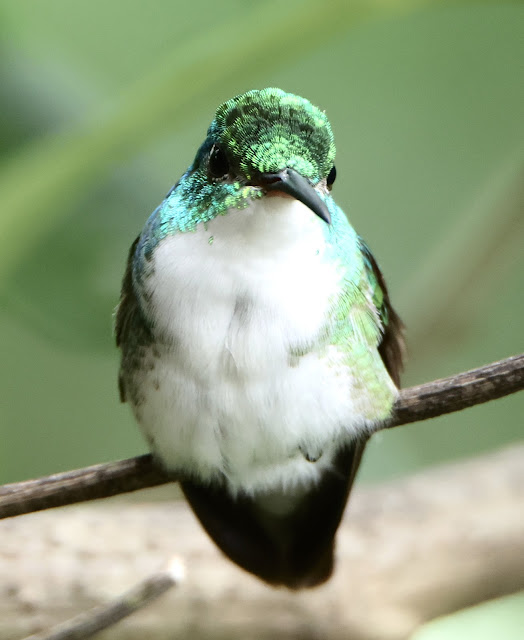 |
| ANDEAN EMERALD |
 |
| BROWN VIOLETEAR |
 |
| GREEN THORNTAIL |
 |
| WHITE-NECKED JACOBIN |
 |
| BROWNISH TWISTWING |
 |
| CHESTNUT-BACKED ANTBIRD |
 |
| GRAY-BACKED HAWK |
 |
| FLAME-RUMPED TANAGER WITH CATERPILLAR |
After breakfast Rosie and I took off toward the south, heading for the next destination, the Urraca Lodge within the Jorupe Reserve. We’d been here before in January and this was certainly a nice place to spend a couple more nights. Following the Google Maps app we headed back to Pinas and Portobela and went south. I now remember reading this was the best route due to a landslide elsewhere. But in hindsight I learned that the landslide had been cleared up, so we traveled about 90 extra minutes to our next destination. In taking the suggested route, we ended up traveling almost 3 hours on a gravel road to finally get to the main highway where we needed to be. The first half hour or more was along a beautiful, clear river. I have to admit it was great scenery, but we only averaged 25 mph while the car took a beating from the washboards and potholes. Going up one mountainside the winds were howling, kicking up the dust so badly that we had to slow way down because the visibility was as bad as a snow storm.


 |
| TYPICAL LANDSLIDE AREA |
But eventually we made it to the pavement, headed SW toward Macara, the city that borders Peru. We were now driving along another ridge and the views were great. We decided to stop at a restaurant for lunch and enjoy the view. Little by little as we descended downward the temperature went upward. After a total of 7 hours driving we arrived at the Urraca Lodge, where Part 2 picks up.



























